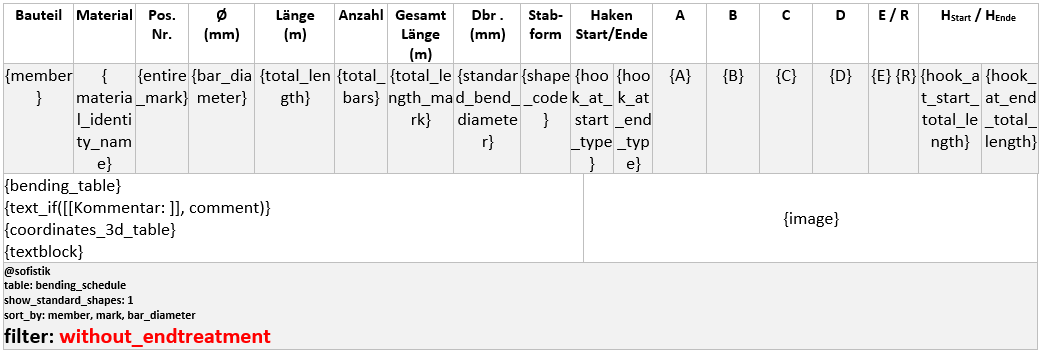Steel list .docx¶
With the command ‘Steel list .docx’ a list of all rebar and meshes is generated, the content of which can be controlled by the template file.
 SOF_B_CREATE_SCHEDULE
SOF_B_CREATE_SCHEDULECommand |
Stahlliste .docx |
Tooltip |
Erstellt eine Stahlliste in einer docx-Datei. |
Ribbon |
None |
Menu |
Bewehrung > Stahlliste .docx |

Workflow overview¶
To create a steel list, simply select a .docx template with the desired format and content. Templates consist of tables and tables consist of retrieval parameters. With this system, you can define the contents of the steel list by adding or removing tables from the document you use as a template. The tables can in turn be modified by adding or removing retrieval parameters. These call parameters are responsible for defining which property is to be displayed in each cell of the table. Anything related to the document format, such as headings, fonts or colors, can be easily edited with the tools offered by Microsoft Word.
The template repository can be found at:
%AppData%\Roaming\SOFiSTiK\2020\SOFiCAD_70_x64\support
There you will find the template DE_SOFiSTiK_Stahlliste_Vorlage.docx. This is the standard template for creating steel lists. If you want to adapt this template to the standards of your organization, please copy and rename it to avoid being overwritten by SOFiCAD when you upgrade.
Creation dialog¶
Structure of a table¶
As a rule, the tables consist of 3 elements: the header, the call parameter body and the SOFiSTiK identification line.
Header: This line is fixed at the beginning of every table. The information in the cells can be freely adapted to your call parameters or translated into other languages.
Retrieval parameter body: The number of lines that can belong to the retrieval parameter body varies between 1 and 2 depending on the type of slab. The retrieval parameter of these lines is replaced by the properties of the element concerned and these lines are repeated as often as reinforcement elements are contained in the dwg file.
SOFiSTiK identification line: This line informs the document generator that the table in which it is contained must be processed accordingly (@sofistik) and what type of table it is (table: bending_schedule). There are also some additional options on this line such as filtering or pure order.
Tables¶
Quantity list¶
(Table: weight_summary)
You can use the quantity list to document the weights of your reinforcing bars separated by diameter. In addition, the quantity list contains a filter to display only bent - or not bent bars or those with a connecting element. These filters can be combined:
Filter: defines a property so that only the elements that have this property are shown in the table. The options are:
with_endtreatment: Only members with fasteners are listed.
without_endtreatment: Only members without fasteners are listed.
bent: Only members that are bent are listed
not_bent: Only members that are straight are listed
Call parameters:
|
|
Bending lists¶
(table: bending_schedule)

The bending list contains all the information required to bend the reinforcing bars.
The following options can be found in the SOFiSTiK identification line:
show_standard_shapes: Controls the creation of bending sketch images.
show_standard_shapes: 0 = No bending sketch is created
show_standard_shapes: 1 = All bending sketches are created
show_standard_shapes: 2 = Only bent bars get a bending sketch
Sort_by: defines the order in which the elements should be listed:
Member = sorting per component
Mark = sorting by item number
Bar_diameter = sorting by diameter
Filter: defines a property so that only the elements that have this property are shown in the table. The options are:
with_endtreatment = Only members with fasteners are listed.
without_endtreatment = Only members without fasteners are listed.
bent = Only members that are bent are listed
not_bent = Only members that are straight are listed
Call parameters:
|
|
Function text_if¶
The “Text_if” function enables the creation of a prefix that is automatically removed if the retrieval parameter with which it is linked contains no information.
- Syntax:
text_if (“Prefix”, variable, “Suffix”)
text_if (“Prefix”, variable)
text_if (variable, “suffix”)
text_if (variable1, variable2)
Example in Word template:
Assumption 1: comment = “This is a comment”, member = “m1”
{text_if([[Comment: ]], comment)}
“Comment: This is a comment”
{text_if([[Comment ]], comment, [[. And finish]])}
“Comment: This is a comment. And finish”
{text_if([[Comment: ]], comment, member)}
“Comment: This is a commentm1”
Assumption 2: comment = “”, member = ”m1”
{text_if([[Comment: ]], comment)}
“”
{text_if([[Comment: ]], comment, [[. And finish]])}
“”
{text_if(comment, member)}
“”
Fasteners¶
(Table: end_treatment)
The Finishing table contains all types of fasteners.
Call parameters:
|
|
Mat list¶
(Table: fabric_schedule)
Call parameters:
|
|
List mats¶
(Table: list_fabric)
Call parameters:
|
|
Mat cutting sketch¶
(Table: fabric_cut)
Call parameters:
|
|
Spacers¶
(Table: barspacer)
Call parameters:
|
|
Built-in parts¶
(Table: mounting_parts)
Call parameters:
|
|
Translation table¶
The translation table is not generated in the result document. It is only used in the template to translate the texts that are generated by default when reading information from the database.
Stamping¶
The information contained in the SOFiCAD stamps can also be exported to the steel list.docx.
So that stamps can be identified as containers for project data, the name of the block must begin with the prefix “PLKO-“.
Call parameters:
The call parameters of the steel list match the name of the block attributes.
Call parameters that relate to project information begin with the prefix “project.”.
|
|
Call parameters that relate to the plan information begin with the prefix “sheet.”
|
|
Difference steel list .docx¶
 SOF_B_CREATE_DIFFERENCE_SCHEDULE
SOF_B_CREATE_DIFFERENCE_SCHEDULECommand |
Differenz-Stahlliste |
Tooltip |
Erstellt eine Differenz-Stahlliste in einer docx-Datei. |
Ribbon |
None |
Menu |
Bewehrung > Differenz-Stahlliste .docx |
The ‘Difference steel list .docx’ command compares the reinforcement information from two dwg files and creates a list of additional rebars and meshes, the format of which can be controlled by the template file.
Note
Please note that two dwg files are required for the comparison. This means that when working with revisions, the file must be saved unchanged before the revision in order to be able to subsequently run the differential steel list.
Creation dialog¶
Total steel list .docx¶
 SOF_B_CREATE_SUM_SCHEDULE
SOF_B_CREATE_SUM_SCHEDULECommand |
Summe-Stahlliste |
Tooltip |
Erstellt eine Summe-Stahlliste in einer docx-Datei. |
Ribbon |
None |
Menu |
Bewehrung > Summe-Stahlliste .docx |
With the command ‘Total steel list .docx’ the reinforcement information is summarized from several dwg files and a weighing list is generated from all rebar and meshes.


